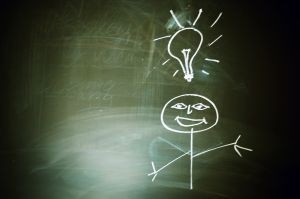The myth of innate genius: how to increase creative potential in young people
Researchers at FAU and Technische Hochschule Nürnberg are investigating the conditions required for creativity in writing and aesthetic production
When is a text a ‘good’ text? And when is a drawing art? Objective criteria for assessing creative performance – whether creative processes or a finished work – are hard to come by. An interdisciplinary research group led by FAU has now proposed a method for developing the creative potential of young people and determined the role that self-reflection plays in creative processes. The researchers aim to develop a modern concept for implementing measures which encourage creativity at universities and schools.
A blank sheet of paper can challenge even the most skilled of authors and artists, and yet the myth of innate genius is firmly rooted in society: whether impressive paintings on canvas as if created by magic, or literary pearls between the pages of a book.
But can you learn to be creative? And if so, how does the creative process take shape when writing or producing art, and how can this be measured? Can existing talents which may have lapsed be developed with the right encouragement? ‘Creativity requires certain conditions and motivation which can vary significantly between individuals. For example, visual methods can encourage creative writing,’ says Susanne Liebmann-Wurmer, Chair of Art Education at FAU.
In the interdisciplinary project ‘Bildnerisches Gestalten und kreatives Schreiben in der Entwicklung des Menschen’ (Art, design and creative writing in human development), a research group led by Prof. Dr. Gabriele Pommerin-Götze from FAU and Prof. Burkard Vetter from TH Nürnberg has found important factors for encouraging creativity among their students: ‘The biggest motivation for writing is things that happen to us, our experiences and our emotions,’ says Pommerin-Götze. Despite ‘a general dissatisfaction with how art and design are taught in schools’ design students believe that individual teachers or mentors can still provide extraordinary motivation.
To measure the individual creative potential of students in art and writing, the research group invited students to workshops where they answered questionnaires on their experiences and needs for working with text and images creatively. This included structural and creativity-orientated textual analyses, open interviews and artist portraits. Based on this input, the researchers proposed a matrix for assessing creative performance objectively, for example according to imagination, originality, stylistic devices, effectiveness, design and form.
In addition, the researchers have also highlighted the aspect of self-reflection in the creative process – the interaction between creative action and reflection: ‘Guiding questions are designed to support students in understanding the interaction between their creative actions and reflection on their individual writing and artistic processes better. This is a useful basis for developing individual writing profiles,’ explains Pommerin-Götze. Often, individuals seek inspiration for their writing or artistic ideas by visiting busy places or speaking with other people. However, when it comes to creative production, most students are more comfortable in a quiet environment – and many prefer working at night.
Freedom for originality
The researchers are using their results so far to develop teaching concepts for universities and schools which utilise the link between creative writing and artistic design and allow more freedom for interdisciplinary projects. Students should also be introduced to the diversity of creative writing and artistic techniques. ‘Young people must be given the freedom to find their way and given the support they need to develop their strengths,’ says Prof. Dr. Susanne Liebmann-Wurmer
Interdisciplinary research project
The interdisciplinary research project ‘Bildnerisches Gestalten und kreatives Schreiben in der Entwicklung des Menschen’ (Art, design and creative writing in human development) was established in 2010 to explore the role of creative writing and design in our futures. The Staedtler Foundation has funded the project with more than one million euros – which is a significantly large sum for a humanities project. FAU is working with the Faculty of Design at Technische Hochschule Nürnberg and Kunst- und Kulturpädagogische Zentrum der Museen in Nürnberg (Centre for Art and Cultural Education of the Museums in Nuremberg) on the project.
The project is divided into five areas which are relevant to all stages in life:
- Denken und bildnerisches Gestalten (Thought and design)
- Schreiben und Malen in der Biographie (Biographical writing and painting)
- Lesen, kreatives Schreiben und Malen als Freizeitbeschäftigung von Grundschulkindern (Extra-curricular reading, creative writing and painting for primary-school children)
- Synergieeffekte zwischen kreativem Schreibens und ästhetischem Gestalten (Synergy effects between creative writing and art)
- Persönlichkeitsbildung durch künstlerisches Gestalten (Personal development through art)
Further information:
Prof. Dr. Susanne Liebmann-Wurmer
+49 911 5302522
susanne.liebmann-wurmer@fau.de
